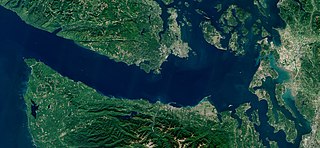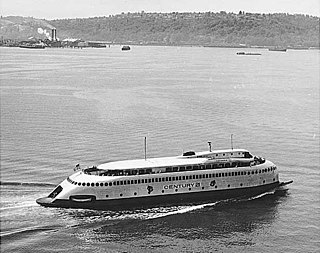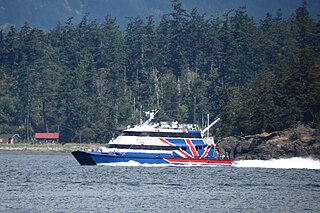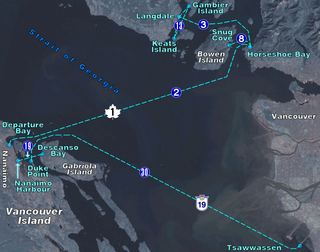
The Strait of Juan de Fuca is a body of water about 96 miles long that is the Salish Sea's main outlet to the Pacific Ocean. The international boundary between Canada and the United States runs down the centre of the Strait.

Washington State Ferries (WSF) is a government agency that operates automobile and passenger ferry service in the U.S. state of Washington as part of the Washington State Department of Transportation. It runs ten routes serving 20 terminals located around Puget Sound and in the San Juan Islands, designated as part of the state highway system. The agency maintains a fleet of 21 vessels that are able to carry passengers and vehicles.

Motor Vessel Kalakala was a ferry that operated on Puget Sound from 1935 until her retirement in 1967.

The MV Nisqually was a Steel Electric-class ferry formerly operated by Washington State Ferries.

The MV Illahee was a Steel Electric-class ferry operated by Washington State Ferries.

The MV Klickitat was a Steel Electric-class ferry operated by Washington State Ferries.

The MV Quinault was a Steel Electric-class ferry operated by Washington State Ferries.

The Steel Electric-class ferries are a class of auto/passenger ferries that became part of the Washington State Ferry System when Puget Sound Navigation Company was acquired in 1951. They were built in San Francisco Bay for service on Southern Pacific and Northwestern Pacific Railroad routes across the bay.

The MV Coho is a passenger and vehicle ferry owned and operated by Black Ball Line. Black Ball's only ferry, Coho carries passengers and cars, motorcycles, trucks, semi-trailers, bicycles, etc. between Victoria, British Columbia, Canada and Port Angeles, Washington, United States.
Victoria Express, also known as Victoria Rapid Transit, was the name of a private, seasonal ferry operation based in Port Angeles, Washington. The service operated two passenger-only ferries on routes between Port Angeles and Victoria, British Columbia and Friday Harbor, Washington during the summer, the 149-seat, 105-foot (32 m) Victoria Express and the 120-foot (37 m) Victoria Express II. Both ferries are gyroscopically stabilized.

The Black Ball Line was a passenger line founded by a group of New York Quaker merchants headed by Jeremiah Thompson, and included Isaac Wright & Son (William), Francis Thompson and Benjamin Marshall. All were Quakers except Marshall.

The U.S. state of Washington is home to a number of public and private ferry systems, most notably the state-run Washington State Ferries.

Clipper Navigation, Inc., is an American ferry operator and subsidiary of Förde Reederei Seetouristik based in Seattle. They provide multiple transportation and vacation packages—many of which are offered under the name Clipper Vacations—including hotel and tour packages in Seattle and in Victoria and Vancouver, British Columbia.

Asbury Park was a high-speed coastal steamer built in Philadelphia, and intended to transport well-to-do persons from New York to summer homes on the New Jersey shore. This vessel was sold to West Coast interests in 1918, and later converted to an automobile ferry, serving on various routes San Francisco Bay, Puget Sound and British Columbia. This vessel was known by a number of other names, including City of Sacramento, Kahloke, Langdale Queen, and Lady Grace.

Colman Dock, also called Pier 52, is the primary ferry terminal in Seattle, Washington, United States. The original pier is no longer in existence, but the terminal, now used by the Washington State Ferries system, is still called "Colman Dock". The terminal serves two routes to Bainbridge Island and Bremerton and has an adjacent passenger-only facility at Pier 50 for King County Water Taxi and Kitsap Fast Ferries routes.
The La Conner Trading and Transportation Company was founded in the early 1900s by Joshua Green and others, to engage in the shipping business on Puget Sound.

The Grand Trunk Pacific dock was a shipping pier in Seattle, Washington. The original pier was built in 1910 and was destroyed in a fire in 1914. The pier was then rebuilt and continued in existence until 1964, when it was dismantled. The area where the pier stood is now part of the Seattle terminal of the Washington State Ferry system.

Princess Marguerite, Princess Marguerite II, and Princess Marguerite III was a series of Canadian coastal passenger vessels that operated along the west coast of British Columbia and into Puget Sound in Washington state almost continuously from 1925 to 1999. Known locally as "the Maggie", they saw the longest service of any vessel that carried passengers and freight between Victoria, Vancouver, and Seattle. The vessels were owned and operated by a series of companies, primarily Canadian Pacific Railway Company (CPSS) and British Columbia Steamships Corporation. The first two were part of the CPR "Princess fleet," which was composed of ships having names which began with the title "Princess". These were named after Marguerite Kathleen Shaughnessy, who was not a princess but was the daughter of Baron Thomas Shaughnessy, then chairman of the board of CPSS's parent, the Canadian Pacific Railway (CPR).

The Bowen Island ferry travels between Snug Cove on Bowen Island, and Horseshoe Bay in the District of West Vancouver, British Columbia, Canada, a trip of three nautical miles across Queen Charlotte Channel. A scheduled ferry has been in operation since 1921, when Bowen Island was a popular holiday destination. Prior to that year, transportation to the island was by steamship from Vancouver, with only one trip daily. The Bowen Island ferry used a fleet of small passenger vessels until 1956, when a single car ferry began passenger service, and that ferry began carrying vehicles in 1958. In 2022 the route carried in excess of 1.2 million passengers plus 570,000 vehicles.

MV Chinook was a luxury automobile ferry designed by William Francis Gibbs, that operated between Seattle, Port Angeles and Victoria under the ownership of Puget Sound Navigation Company.






















